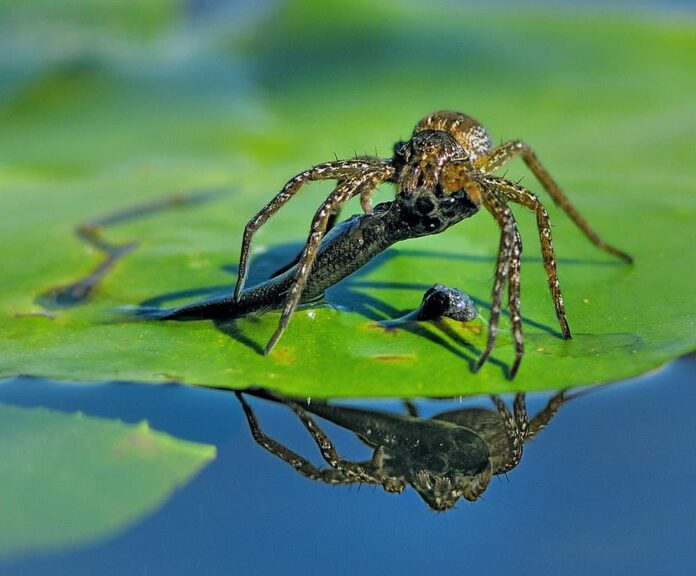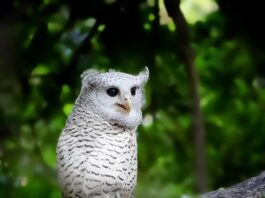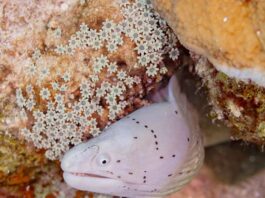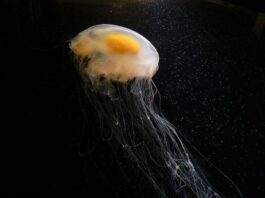Spiders never cease to surprise us, don’t they? Water spiders are aquatic arachnids that can glide on the water’s surface or live underwater. As aquatic dwellers, these creepy crawlies feed on aquatic insects, small fish, and anything they can hunt. For those who are curious about spiders that can swim, check out the list below.
1Amazon Giant Fishing Spider
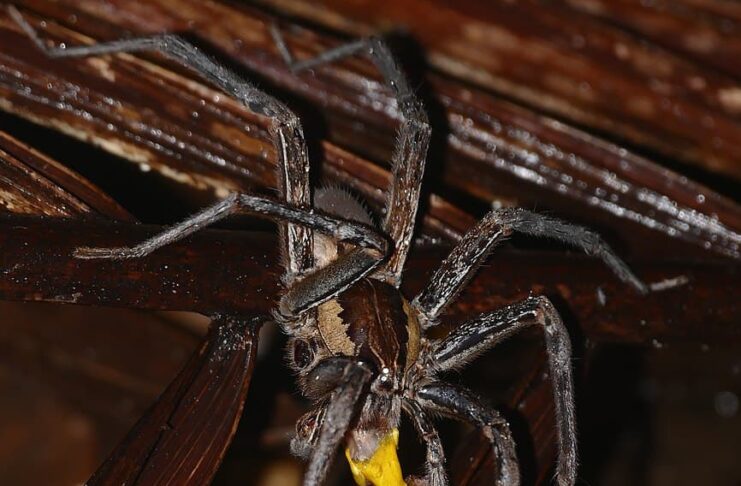
Scientific Name: Ancylometes Rufus
The Amazon giant fishing spiders are not only large but also strong enough to catch fish for meals. With a leg span of 12 centimeters, these spiders are able to walk on water without a problem. Even scarier, they can also dive and swim under the water as well. Their hunting strategy is quite simple, these spiders simply pounce on the fish and then bite to inject the venom. The spider then drags the fish to the surface and starts feasting.
As water spiders, these arachnids live near lakes and rivers where they can hunt. Their regular meals consist of amphibians, fish, insects, lizards, and other small mammals. Since this one is native to the Amazon, you can find them in South America from Ecuador and Peru to Brazil and Venezuela. So next time you visit the areas, make sure to watch out for these ambush predators because their bites are painful.
2Bob Marley’s Spider
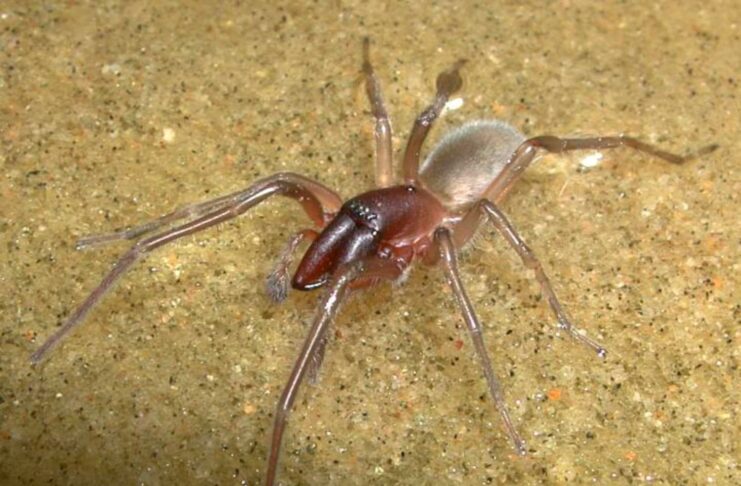
Scientific Name: Desis Bobmarleyi
Discovered in 2017, this new species of water spider receives its name after the Jamaican reggae singer and songwriter Bob Marley. Because these spiders live in a “high tide low tide” habitat, it inspired researchers to name them after Bob Marley’s song. While most water spiders are large, this species is rather small in size. However, the Bob Marley’s spider has long hairs on their abdomen and legs just like other aquatic arachnids.
Thanks to those tiny hairs, the spiders are unable to breathe and survive between the high and low tide zones. During hide tides, these spiders hide in barnacle shells, corals, or holdfasts of kelp where they build air chambers. Once the low tides begin, the spiders come out and hunt small invertebrates on the surfaces near where they live.
This water spider species is native to the corals of Australia, and their population probably widely distributes along the coasts. The thing to be concerned about is that climate change has been playing a massive part in coral reef destruction. As for their current population status, it is not clear whether or not it is an endangered species.
3Dark Fishing Spider
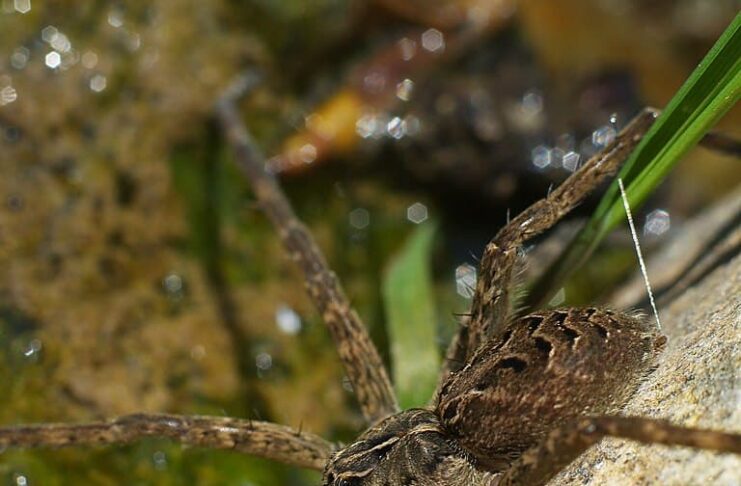
Scientific Name: Dolomedes Tenebrosus
There are many species of fishing spiders, and this one is among the most interesting. This species is only found in Canada and the United States, and they usually dwell on trees or in wooded areas. However, these spiders are mostly found near shallow pools of water where they hunt for aquatic insects and minnows. Sometimes, people also see them in homes and other buildings where their appearance freaks people out. Their venom is equivalent to a bee sting, and they will only bite if harassed or threatened.
Dark fishing spiders are ambush hunters, and they use the hair on their legs to detect vibrations underwater. Once a prey comes close by, the spider will grab the prey and then deliver the bite to inject venom. Since these spiders are lightweight, they are able to walk on the water surface with ease. Along with that, they are also able to dive into the water with the help of the hair on their body in breathing.
4Diving Bell Spider
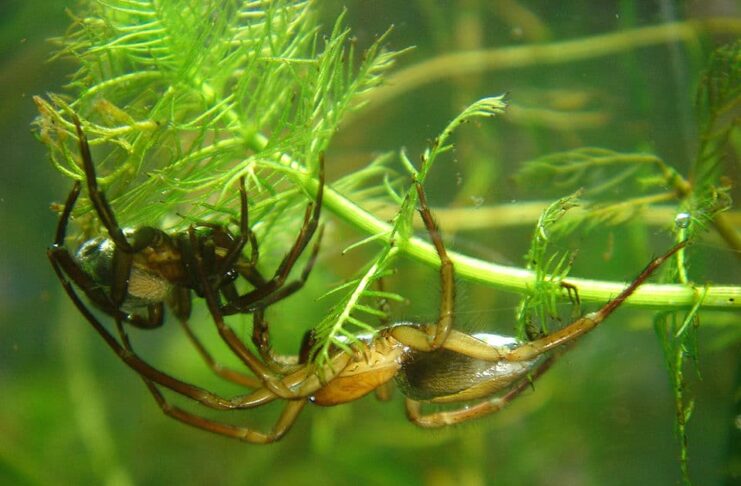
Scientific Name: Argyroneta Aquatica
This is the only known species of spider that spends almost its entire life underwater. From catching prey, eating prey, and egg laying to mating and resting, diving bell spiders do them all under the water. When it comes to true aquatic spiders, this is the only known species so far. So how can these spiders live and do other things underwater? Thanks to the silk-based structure that the spiders use as special breathing tubes, they are able to breathe underwater. This airbag allows the spider to stay under the water for about an hour before coming up to the surface.
On top of that, the diving bell spiders have 8 long and thin legs with a lot of tiny hairs. Those tiny hairs over their bodies trap tiny air bubbles that allow them to breathe and stay up to 40 minutes underwater. This species is found in clean freshwater habitats from Europe to Asia and Australia. These water spiders live in lakes, ponds, slow-running streams, and other areas with aquatic vegetation. As carnivores, they feed on insects, small fish, tadpoles, and other prey that they can catch underwater or on water surface.
Do water spiders bite humans? Yes, they do if you provoke them. The bite from this spider is quite painful, and the venom can cause some unpleasant symptoms in patients. Those include feverishness, localized inflammation, vomiting, etc. Because their fangs are strong enough to pierce human skin, the bite is also visible. So if you see a water spider in the pond somewhere, just leave it be and avoid touching it.
5Giant Water Spider
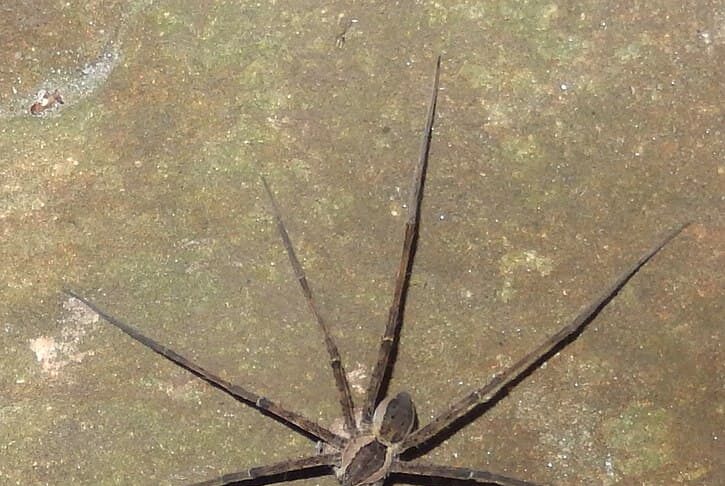
Scientific Name: Megadolomedes Australianus
As for this one, it is not only among the water spiders but also one of Australia’s largest spiders. Its leg span is so big it can grow up to 18 centimeters, covering your whole face in case it drops on you. While most water spiders out there are able to glide or walk on water, this one can run. At the same time, the giant water spiders are also good swimmers as well. This great swimming ability helps them to catch aquatic prey such as insects, small fish, tadpoles, and more.
Similar to the diving bell spiders, this one also uses its body and leg hair to trap air bubbles for breathing underwater. That way, they are able to submerge and stay under the water for a long period of time during hunting. This species is normally found near creeks and ponds, and they live in the eastern part of Australia. Giant water spiders are harmless to humans, but they can and will bite if provoked.
6Raft Spider
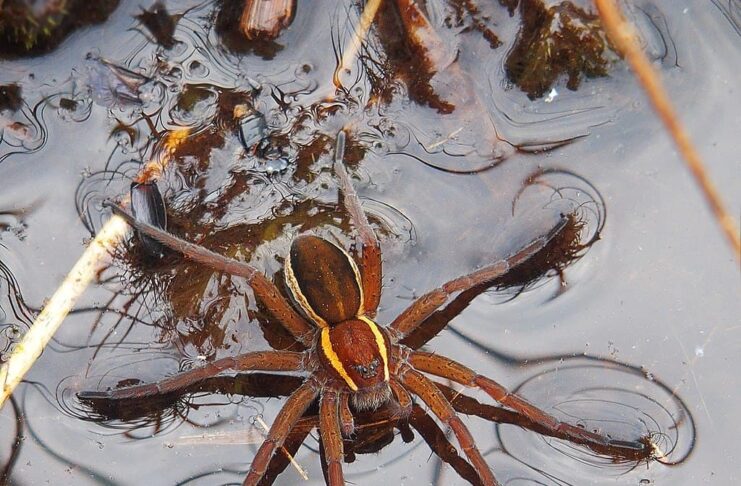
Scientific Name: Dolomedes Fimbriatus
A raft spider gets its name from its hunting behavior. Most of the time, this spider sits near the water with its legs touching the surface. Once it detects the prey’s vibration, it rushes out to catch it and it floats like a raft. These large and chunky spiders usually live at the edge of the water or on floating vegetation where food is abundant. Their meals consist of invertebrates, larvae, small fish, tadpoles, and aquatic insects. Apart from being able to walk on the water, raft spiders can also dive, submerge, and swim beneath the surface. The spiders do so when hunting and threatened, and they are harmless to humans despite their large size.
7Spotted Fishing Spider
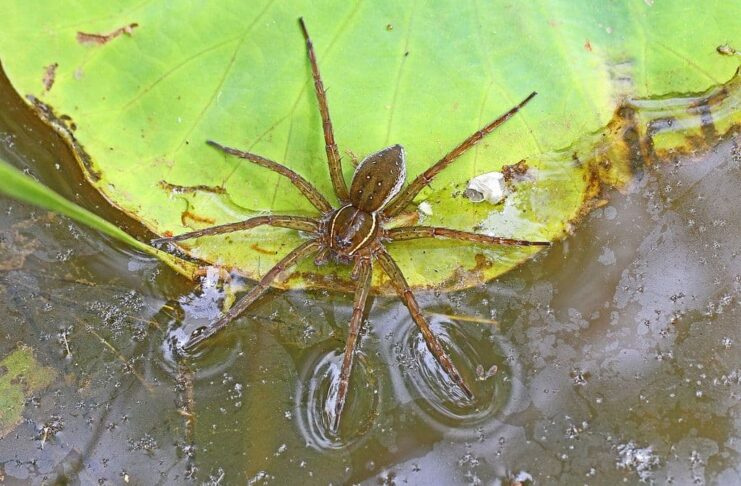
Scientific Name: Dolomes Triton
The distinctive appearance of this water spider species is not difficult to recognize. A spotted fishing spider has long legs with dark colors, and there is a whitish-yellow stripe surrounds the dark carapace. On top of its dark brown abdomen is a few pairs of tiny white spots with dot shapes; hence the name. Not different from the giant water spiders, this species is also capable of running very fast as well.
Those long legs of the spiders contain delicate hairs that respond to vibration through air or water. They give the spiders the information about presence and location of prey via the spider’s nervous system. This is why these water spiders can accurately locate and successfully hunt their prey every single time. The best part is that their unique sensory structure also gives them the presence of predators nearby which is super cool.
Another impressive thing about spotted fishing spiders is that they are capable of capturing fish 5 times their body size. Thanks to their strong venom, these arachnids can immobilize and kill their prey without a problem. These ferocious predators hunt during the day, and their meals include frogs, small fish, tadpoles, and more. Also, their venom is not dangerous to humans although they will bite if poked or prodded.
8Stretched Spiders
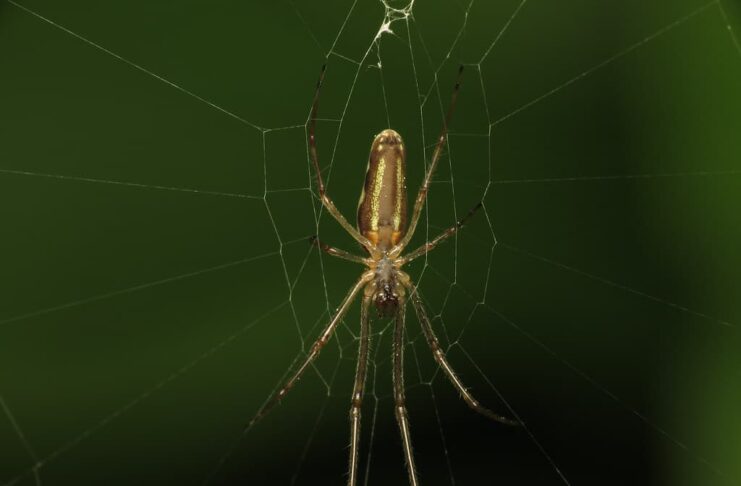
Scientific Name: Tetragnatha Extensa
Goes by another name “Longjawed Orbweavers”, stretched spiders often stretch out their two front pairs of legs when they rest. The appearance of this species is somehow unique due to their elongated bodies with long legs, and of course, extended jaws. The habitats of stretched spiders are in low-growing vegetation and tall grasses, and often near boggy areas or water. Unlike most water spiders, this one spins webs. Their webs are circular in shape, and those orb webs have an open center without threads at all. The position of the webs is horizontal, and it is usually a few feet from the water’s surface.
Related Post: Largest Spiders In The World

